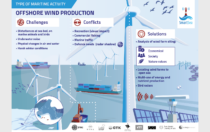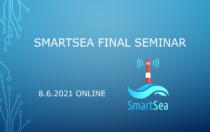Combined RAS and offshore farming offers advantages over traditional production cycle of rainbow trout

The combined use of land-based RAS (recirculation aquaculture systems) during the first winter with sea cage farming for the second summer can considerably shorten the production cycle, due to fast growth at stable RAS conditions. Similar development of combining RAS and cage production is also going on in Norwegian salmon industry.
To test this method one summer old all-female rainbow trout (Oncorhynchus mykiss), initial weight of 60 g, were reared in RAS during winter season and transferred to net cages for one summer season (Figure). During the RAS period individual tagged fish were divided in three different feeding groups and reared in triplicates:
1. ad lib; ad libitum feeding.
2. ad lib. SF; ad libitum feeding combined with 23 day-a-long spring fasting period.
3. ad lib. 75%; restricted feeding (75 % of ad libitum feeding level) throughout the RAS period.
Different feeding treatments were organized due to anecdotal evidence that fish grown at RAS show reduced growth when transferred from RAS to sea cages. At the sea, all groups were fed ab libitum.

Results
After the RAS phase, the ad lib group had the highest weight (410 g) and weights in restricted feeding (280 g) and in spring fasting (315 g) groups were significantly lower.
After the sea cage period the ad libitum group had still the highest weight (1.7 kg) and the final weight of fish in two other groups was significantly lower (table). However, the fish in ad lib. SF and ad lib. 75% groups showed compensatory growth response during sea cultivation phase and their growth rate (Thermal growth coefficient) were significantly higher than in ad libitum group. Fish in all groups were immature probable because young age (18 months).

Conclusions
The study suggests, that combined RAS and offshore farming offers advantages over traditional production cycle due to avoidance of unwanted maturation. Despite of compensatory growth response of fish during sea phase, no clear evidence that restricting the feeding in RAS would be beneficial, was not obtained.
J. Koskela, J. Vielma, J. Riihimäki, M. Pellinen, J. Bomberg
Natural Resources Insitute Finland (Luke)
Articles

Pohjanlahti merituulienergian tuotantoalueena
Konteksti Merituulienergian laajamittainen rakentaminen on keskeinen askel Suomen tavoitetta hiilivapaaksi yhteiskunnaksi. Suomen merialueista erityisesti Pohjanlahti tarjoaa hyvät olosuhteet energian tuotannolle,

Scientific Articles published in SmartSea
One of the products of the SmartSea are the various scientific articles published by our partners during the project. The

SmartSea Infographics
Offshore wind production, Aquaculture, Fisheries, Blue Well being, recreation and tourism have been key areas of the SmartSea project. We

SmartSea Final Seminar/Loppuseminaari 8.6.2021
SmartSea will hold a Final Seminar on the results of the project, and a discussion with stakeholders and affiliates on
